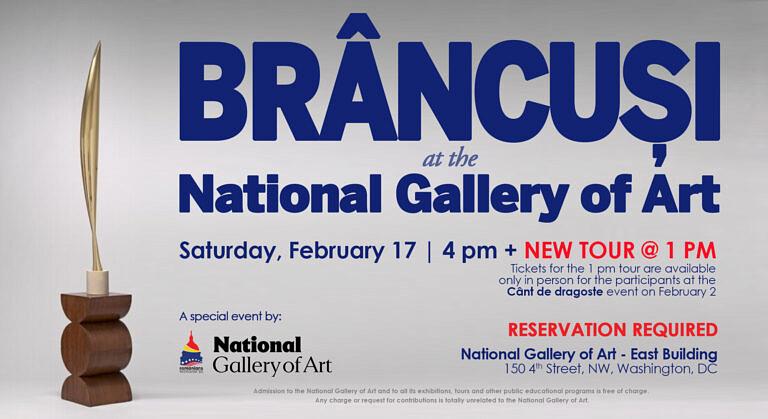US National Gallery of Art in Washington to hold tour celebrating Romanian sculptor Constantin Brâncuși



NGO Romanians of DC, together with the United States National Gallery of Art, recently announced a special guided tour “Brâncuși at the National Gallery of Art – Breaking the Rules in Modern Art.” The hour-long tour will be centered on the sculptures by Constantin Brâncuși the National Gallery of Art has in its collection and will place his art into the wider context of the modernist art movement.
The event marks Brâncuși’s Day, an annual holiday designed to celebrate the life of the Romanian artist widely considered one of the most influential sculptors of the 20th century and the father of modernism.
Two guided tours will take place on Saturday, February 17 at 1:00 and 4:00 PM in the East Building located at 150 4th Street, NW, Washington, DC.
The 4 PM tour is sold out and tickets are going out fast. Registration for the 1 PM tour will be first made available, in person and while available, to the participants at the Cânt de dragoste event scheduled for Friday, February 2. Registered participants will receive additional information about the logistics of that day via email.
The event is free but participation is possible only with a confirmed ticket.
Born in Hobița, Romania, on February 19, 1876, Brâncuși studied art at the Școala de meserii in Craiova from 1894 to 1898 and at the Școala Națională de Arte Frumoase in Bucharest from 1898 to 1901. In 1904, Brâncuși left Romania for Paris where he enrolled at the Ecole des Beaux-Arts in 1905. From 1907 until his death, he worked largely on his own, systematically forging an original modernist sculptural style.
In 1935 the artist received an important public commission for a war memorial in Târgu Jiu, Romania. For this commission, he designed a complex that included a ceremonial portal, tables, stools, and the sculpture known as the Endless Column. In 1952, Brâncuși became a French citizen. He died in Paris on March 16, 1957.
Brâncuși’s work has inspired a host of modern sculptors, from Barbara Hepworth, Henry Moore, and Isamu Noguchi (who worked as Brâncuși’s studio assistant in 1927) to Carl Andre, Donald Judd, and Dan Flavin.
(Photo source: Romaniansofdc.org)